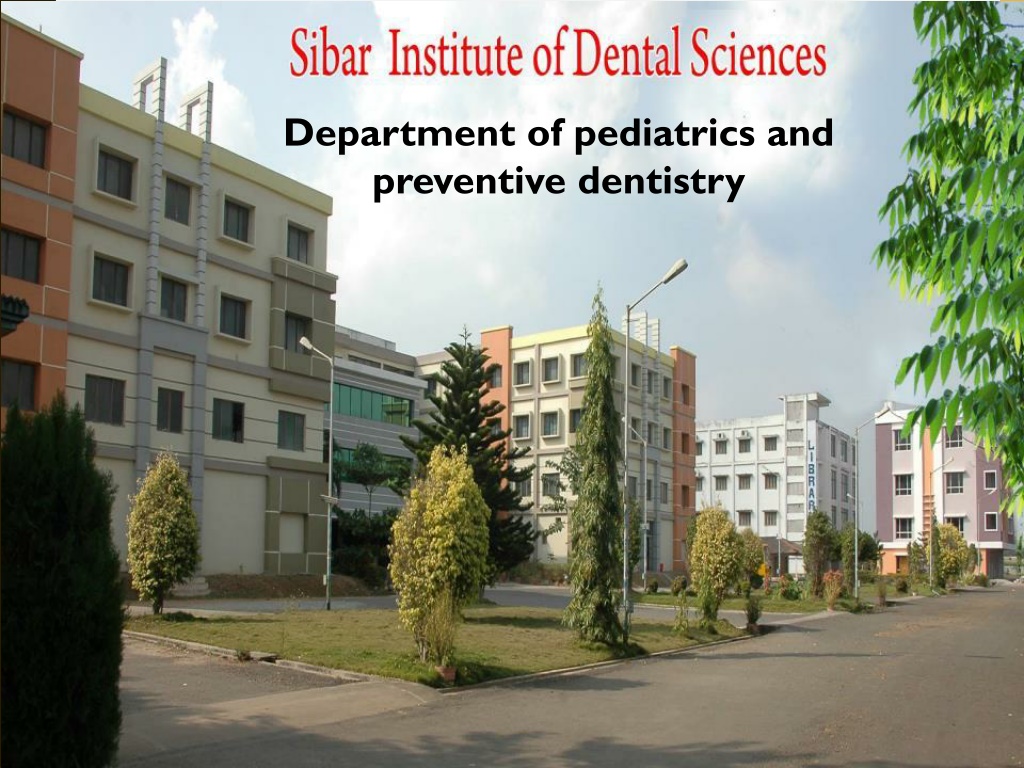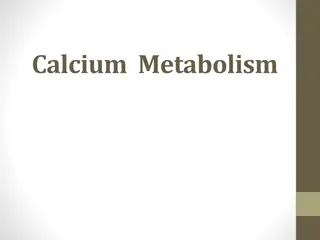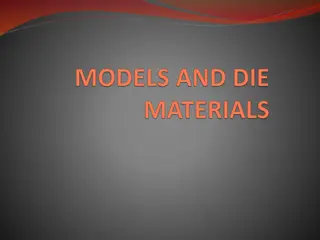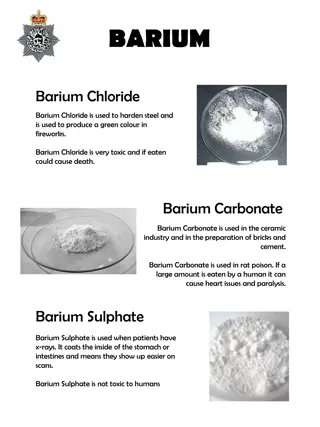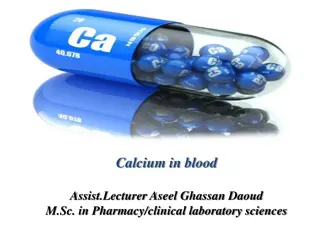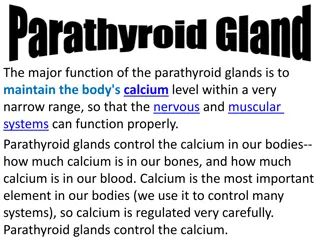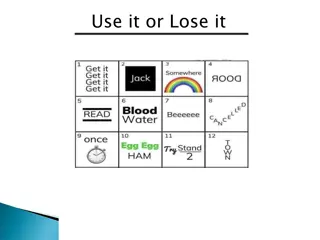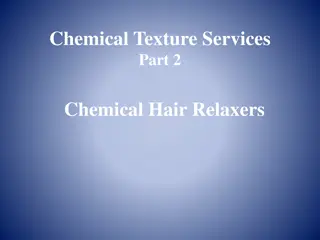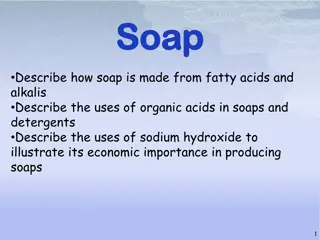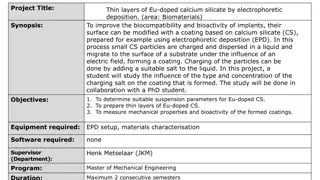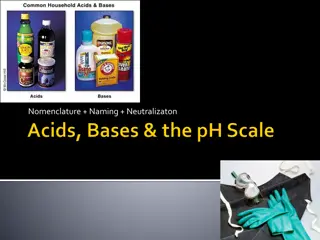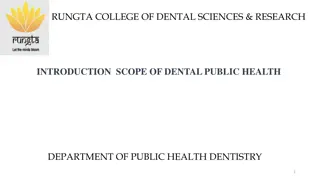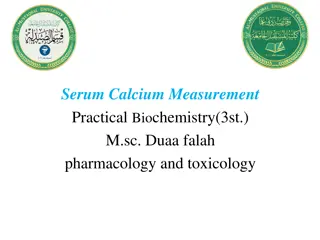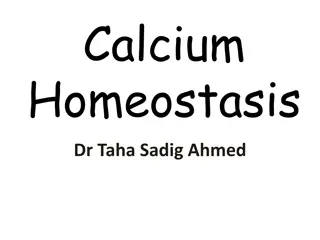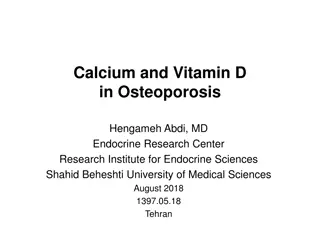Calcium Hydroxide in Dentistry: Properties, Classification, and Availability
Calcium hydroxide, a versatile material in dentistry, has various properties such as high solubility, low setting time, and strong alkali nature. It is classified into non-setting and setting cements used for cavity lining, root canal sealers, and more. Available in powder form and as a light-cure single or two-paste system, it plays a vital role in promoting repair and inhibiting tooth resorption. Its mechanical and biological properties make it a biocompatible material with antimicrobial effects. The compound's history, sources, and applications in dentistry are outlined in detail.
Download Presentation

Please find below an Image/Link to download the presentation.
The content on the website is provided AS IS for your information and personal use only. It may not be sold, licensed, or shared on other websites without obtaining consent from the author. Download presentation by click this link. If you encounter any issues during the download, it is possible that the publisher has removed the file from their server.
E N D
Presentation Transcript
Department of pediatrics and preventive dentistry 1
CALCIUM HYDROXIDE 2
INTRODUCTION Ca(OH)2 - A SPECIAL PAL 3
HISTORY: Nygren(1838) = fistula dentalis . Codman(1851) was the first to attempt to preserve the involved dental pulp. Hermann in 1920 = pulp-capping agent - Endodontics Rhoner(1940) = Root canal filling material. 4
SOURCE 900 and 12000c CaCO3 CaO+Co2 Lime stone CaO+H2O Ca(OH)2 Quick lime Slaked lime 5
PROPERTIES Chemical Physical Colour less Amorphous matrix with crystalline fillers Better insulator Thermoplastic- high viscous- temp Adaptability film thickness (70-90 u) low Setting time 2.5 to 5.5 mins Setting time increased by catalyst, dryness and cold Setting shrinkage low 5% Solubility higher Strong alkali Molecular wt 74.09. Density is 2.24 and Melting point is 5800c. 6
Mechanical Compressive strength up to 800 psi Tensile strength is very low of about 1.0 mpa. Visco elastic Biological Biocompatible material. Anti microbial Tissue dissolving ability Inhibit tooth resorption Induction of repair by hard tissue formation 7
Classification Classification Non Setting cement Setting cement Lining or sub-lining of the cavities Root canal sealers. Dressing root canals. pulpdent Hydrex, Dycal 8
AVAILABILITY Powder form suspension 9 Light cure single paste system Two paste system
Two paste system Catalyst paste: - Alkyl salicylate (Iso-butyl salicylate or 1-methyl triethylene salicylate) Inert fillers titanium oxide : 12-14% Radiopacifier barium sulphate: 32-35% Calcium tungstate or calcium sulphate: 14-15% Basic paste: Calcium hydroxide : 50-60% Plasticizer (sulfonamide or paraffin oil) 10
Light cure single paste system Urethane dimethacrylate Hydroxymethacrylate (HEMA) Calcium hydroxide Polymerization activators Barium sulphate 11
CHEMICAL REACTION CHEMICAL REACTION Chelation reaction Continous phase chelates of calcium ALKYL SALICYLATE Interrupted phase unreacted particles Compressive strength continues to increase over a 24-hour period. When calcium hydroxide is carried by methylcellulose or any other biologically compatible and degradable polymeric material - monomers will polymerize creating a porous meshwork. 12
VEHICLES USED VEHICLES USED According to Fava and Holland Aqueous Viscous Oily 13
AQUEOUS: Aqueous suspension of Methylcellulose or Carboxymethyl cellulose Water Saline LA Detergent Ringers lactate CLINICAL IMPORTANCE: Promotes a high degree of solubility The root canal must be redressed several times there by increasing the number of appointments. 14
COMMERCIAL AVAILABILITY Calxyl: Introduced by Hermann Pulpdent and Tempcanal Calasept Hypocal 15
VISCOUS: Polyethylene glycol Glycerin Propylene glycol CLINICAL IMPORTANCE: Promote a lower solubility of the paste - Higher molecular weight. Release calcium and hydroxyl ions more slowly for extended periods. Number of appointments and redressings of the root canal is drastically reduced. Commercial availability: Calen Calen + camphorated parachlorophenol Calcium hydroxide + CMCP = Broader & faster antibacterial action 16
OILY: Camphor Olive oil Silicone oil Metacresyl acetate fatty acids CLINICAL IMPORTANCE: promote the lower solubility and diffusion of the paste with in the tissues than viscous COMMERCIAL AVAILABILITY: Endoapex: calcium hydroxide, liquid silicone and iodoform. Vitapex: 17
IMPORTANCE OF VEHICLE Eg : Dental replantation cases 1st appointment Aqueous vehicle : resorption. for rapid ionic release and pH turnover to avoid replacement Subsequently - Viscous vehicle should be used for to remain in the root canal for longer period. 18
Mechanism of action Calcium Hydroxide High alkaline PHactivates alkaline phosphatase enzyme Bacteria Host tissues Liberation of inorganic phosphate Damage to DNA Damage to cytoplasmic membrane Protein denaturat ion Inorganic phosphate combine with calcium from blood Formation of calcium phosphate which is molecular unit of hydroxyapatite Ca(OH)2 has the capacity to extract growth factors from the dentin matrix, causing the formation of a dentin bridge. 7th to 10 th day 19
Role of calcium ions: Reduce the permeability of new capillaries in granulated tissue of de- pulped teeth -Reduced serum flow -Reduce the inhibitory pyrophosphate ion which is an important factor during mineralization (Hiethersay 1975) Act in the complement system activity of the immunological reaction (Tronstad et al. 1981) Spoto et al. conducted a study to assess the alkaline phosphatase (ALP) activity in normal and inflamed dental pulps. normal healthy pulps were 110.96 +/- 20.93. In the reversible pulpitis - 853.6 +/- 148.27. In the irreversible pulpitis - 137.15 +/- 21.28 They concluded that the differences in the levels ALP could have a role in the initial pulp response to the injury. 20
CLINICAL APPLICATIONS CLINICAL APPLICATIONS Fractures & perforations Apexification Liner Base & sub base Weeping canals Rc sealer Pulp capping agent Miscellaneous Traumatology Intra canal medicament Pulpotomy Peri apical lesions Pulpectomy 21
liner Not interfere with the setting reaction of any other restorative cements, Hard to resist the applied condensation pressures that are required even for the lathe cut amalgam alloys. Base & sub base It helps in repair of pulpal tissue It provides chemical insulation Calcium hydroxide bases are of relatively of low strength when compared to the other bases. These bases are used only for their therapeutic benefits, chemical insulation 22
CAN BE USED AS LONG TERM SEAL? Ca (OH)2 is highly soluble in water and marginal leakage will wash out the material. After dissolution of the material, this would leave a restoration which is unsupported and thus prone to fracture. Robchinsky and Donly et al compared Glass lonomer Cement and Calcium Hydroxide liners in class II amalgam Restorations Marginal leakage & marginal demineralization Ca(OH)2 > GIC 23
Remaining dentin thickness - 5-10 micrometers or less. Long-term clinical studies - failure rates increase with the follow-up time. Disadvantages for this material include Gradual degradation and tunnel defects in the newly formed dentin. Increased frequency of inflammatory cells localized areas of pulp necrosis have been reported during differentiation, extracellular matrix secretion and subsequent mineralization. 25
DIRECT PULP CAPPING AGENT Direct pulp treatment involves the placement of a biocompatible agent on the healthy pulp tissue that has been inadvertently exposed by caries excavation or traumatic injury. The treatment objective is to seal the pulp against bacterial leakage and encourage the pulp to wall off the exposure site by initiating a dentin bridge and maintain the vitality of the underlying pulp tissue organ. 26
PULPOTOMY AGENT vital pulp therapy for primary and young permanent teeth with carious pulp exposures. A pulpotomy is defined as the surgical removal of the entire coronal pulp leaving intact the vital radicular pulp within the canals. A germicidal medicament is then placed over the remaining vital radicular pulp. In permanent teeth = calcific bridge formation In primary teeth it is likely to cause internal resorption. 27
Calcium hydroxide pulpotomy in primary teeth: Subramanyam et al (2012) 28
Pulpectomy agent A healthy primary tooth is the ideal space maintainer. Extrudes the beyond the apex less periapical reaction Resorbs faster than primary root It creates a sterile environment in the canal thereby inhibiting the infectious process. Calcium hydroxide is especially indicated in children undergoing irradiation therapy as other materials are considered mutagenic, toxic and allergic. 29
The common commercial calcium hydroxide preparations used as a filling material are Vitapex and Endoflas. Vitapex is a viscous mix of calcium hydroxide and iodoform Endoflas is a resorbable paste, it contains similar components as Vitapex, with the addition of zinc oxide eugenol. Endoflas immediately resorbs when extruded extraradicularly, but does not wash out intra-radicularly. 30
Apexification agent Apexification is a procedure promoting the formation of a barrier that closes the open apex of an immature permanent tooth with a non-vital pulp so that the filling materials are contained within the root canal space Immature roots with open apices may be managed with calcium hydroxide in either a pulpotomy procedure with calcium hydroxide placement over the vital radicular pulp (apexogenesis) or as temporary root canal filling material in cases of nonvital immature teeth (apexification). 31
AS A intra canal medicament AS A intra canal medicament Addition of chemicals such as p-chlorophenol and chlorhexidine - enhance the effectiveness of calcium hydroxide pastes The pretreatment of root canals with calcium hydroxide enhances the tissue-dissolving capability of sodium hypochlorite 32
Calcium hydroxide is a slowly working antiseptic. Calcium hydroxide powder+ saline/ water This slurry is best applied with a lentulo-spiral. It has a wide range of antimicrobial activity against common endodontic pathogens, but is less effective against Enterococcus faecalis and Candida albicans. Calcium hydroxide is also an effective antiendotoxin agent. Saturated Calcium hydroxide solution mixed with a detergent is an effective antimicrobial agent suitable for irrigation. Foster et al. demonstrated that removal of the intra canal smear layer may facilitate Ca (OH)2 diffusion 33
As a root canal sealer In the root canal obturation sealer plays an important role. Sealer basically fills the gap between the walls of the prepared dentine and the gutta-percha Thus one major concern is that the calcium hydroxide content dissolves leaving obturation voids - ruin the function of the sealer. Rationale: canals with wide apical foramina, perforations or fractures, mineralized repair may further be induced. 34
Sealapex and Calcioboitic Root Canal Sealer (CRCS), Apexit. Sealapex released more ions and disintegrated more rapidly than CRCS. It was also found that although the release of calcium ions from CRCS was negligible, the material continued to alkalize its environment possibly due to the free eugenol combining with calcium ions as they were released. 35
AS AN APICAL PLUG In situations where there is an open apex or indeed normal apical anatomy the dentin chip plug in the periapical tissue has been advocated as an artificial but biological apical stop against which guuta- percha can be condensed. The intentional extrusion of calcium hydroxide powder to act as an apical stop enabling condensing of gutta-percha has been advocated with good clinical success rates. 36
Peri apical lesions Calcium hydroxide can be used as a root canal dressing in teeth with large periapical lesions and in cases where it is necessary to control the passage of periapical exudates into the canal. Morrier compared the antibacterial activity of five commercial calcium hydroxide products (XR_SPAD, Calcicur, Hycal, Root-Cal and Hypo- Cal ) and two calcium hydroxide mixtures (with water and glycerin) on the growth of three anaerobic bacteria associated with endodontic infections namely porphyromonas endodontalis, fusobacterium nucleatum and prevotella intermedia and saliva bacterial strains were also determined. They concluded that calcium hydroxide mixed with glycerin showed the largest zones of bacterial inhibition where as Root-Cal was the least active. 37
Weeping canals The mechanism whereby the reduction of the seepage occurs is probably due to: The formation of a fibrous barrier when calcium hydroxide is placed in direct contact with the host tissues. The contraction of the capillaries Acts as a mechanical barrier. By altering the acidic environment 38
Repair of iatrogenic perforations It has been reported that perforations of the root canal wall by the instruments or posts may takes place accidentally. The early preliminary dressing of the perforations with calcium hydroxide is very important to prevent the in growth of granulation tissue. 39
Horizontal fractures RCT- In appropriate extrusion of sealer from fracture site preliminary dressing of calcium hydroxide - 3-6 months may encourage soft tissue healing and possibly mineralization at the fracture site. This will provide a barrier for the subsequent condensation of the filling material. 40
In traumatology In traumatology For many decades calcium hydroxide has been the main material used to treat a variety of pulpal healing complications in dental traumatology such as Teeth with exposed pulps (pulp capping, pulpotomy), Teeth with incomplete root formation and pulp necrosis (apexification), Teeth with root fractures Teeth with infection-related external root resorption 41
International Association of Dental Traumatology (2007) guidelines recommend- that any tooth with a necrotic pulp associated with a luxation injury should be dressed with a calcium hydroxide medicament until the root canal is filled. Intracanal medicaments containing calcium hydroxide are used to control internal resorption (Haapasal and Endal 2006) inflammatory apical root resorption (Majorana et al. 2003). For avulsion injuries, the use of calcium hydroxide medicament is recommended for up to 1 month (Kawashima et al. 2009).45 42
miscellaneous As a dentin desensitizing agent: Physical blockage of the tubule orifices. Production of precipitates or mineralization. Stimulation of reparative dentin. 43
As a micro leakage demonstrator: Novel application Simple, biocompatible and a quick way to detect micro leakage. Based on the solubility and hydroxyl ions release of the cements. Method: Ca(OH)2 lining restorative material was treated with ice cold water pH paper placed over the fillings by noting the color change of the pH paper, Subsequent micro leakage can be detected. 44
Calcium hydroxide in the pin retained restorations: The tip of the pin is then soaked in the calcium hydroxide paste and inserted very gradually into the pin channel stopping short of the pulpal penetration. This promotes healing by calcific barrier provided at the pulp-dentin interface. 45
COMBINATIONS Calcium hydroxide + ledermix (corticosteroid+antibiotics) and integrity of the injured pulp tissue corticosteroids to reduce inflammation and maintain the vitality Calcium hydroxide +chlorhexidine More antibacterial efficacy 46
TOXICITY Previous studies shown that Ca (OH)2- 1 mmol is extremely toxic to cells in tissue culture Recent studies more biocompatible. Has tissue altering and dissolving effects Vero observed that the biocompatibility of calcium hydroxide was better than that of tricalcium phosphate. 47
Dycal, Life and Sealapex have been associated with toxicity in the form of cytotoxicity, genotoxicity, neurotoxicity, phototoxicity, necrotic and inflammatory manifestations = Neuro Cutaneous Syndrome (NCS). Ethyltoulene- Neurotoxin The sulfonamide - cause of the cutaneous symptoms Schawrtz, it is dangerous if calcium hydroxide flows out of inferior alveolar canal which would cause neurotoxicity. 48
SUMMARY Advantages Disadvantages Initially bactericidal then Does not exclusively stimulate bacteriostatic dentinogenesis Promotes healing and repair Associated with primary tooth resorption High ph stimulates fibroblasts May dissolve after 1 year with Neutralizes low ph of acids cavosurface dissolution Stops internal resorption May degrade during acid etching Inexpensive and easy to use Degrades upon tooth flexure Particles may obturate even tubules Marginal failure with amalgam condensation Does not adhere to the dentin or resin restoration 49
CLINICAL APPLICATIONS CLINICAL APPLICATIONS Fractures & perforations Apexification Liner Base & sub base Weeping canals Rc sealer Pulp capping agent Miscellaneous Traumatology Intra canal medicament Pulpotomy Peri apical lesions Pulpectomy 50
